Main Line Kitchen Design does an analysis of the storage space advantage of frameless vs. framed cabinetry.
Many customers select European frameless cabinetry over more classic framed cabinetry because they want additional storage. This isn’t surprising since the drive to maximize storage space in a kitchen is frequently the motivating factor for many kitchen decisions. However, often the reasoning behind these decisions is either flawed or the advantage is overvalued.
Let’s do some math to compare the additional space gained by using frameless cabinetry over more durable framed cabinet construction.
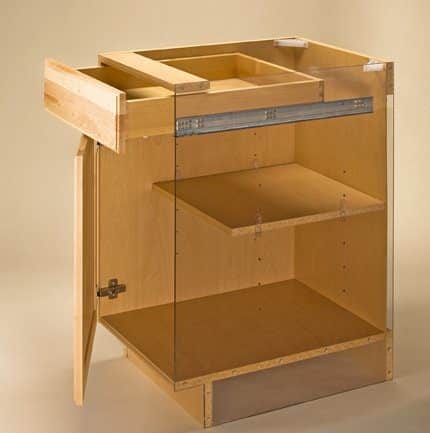
Above is a cross section of a cabinet built using the frameless method of construction. Notice the cabinet box is simply a back, bottom, top, and sides. The front of the cabinet is missing. Below is an example of a framed cabinet. Notice the front frame on the cabinet that the drawer passes through and that the hinges and hardware are attached to.
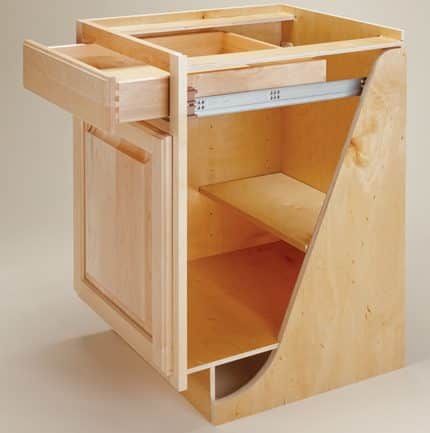
Better made framed cabinets usually use 1/2″ thick sides and a solid wood face frame with horizontal and vertical pieces 1 1/2″ wide x 3/4″ thick. Better made frameless cabinetry uses 3/4″ thick sides and the cabinet has no front at all. This means that the hinges and drawer tracks are all attached to plywood or particle board sides on a frameless cabinet as opposed to solid wood on a framed line. However, it also means that all roll outs, drawers, and pull outs must pass through the reduced size opening in the front of a framed cabinet.
What’s the difference in storage between the two options?
Let’s do the math!
First, the inside of both boxes is essentially the same since the width of the inside of a cabinet is identical in both framed and frameless examples. While the frame does take up a tiny bit of space it is far less than 1% of the total cabinet space. It is only in the drawers and the roll outs that space is reduced significantly. This is because moving parts needing to pass through a smaller cabinet front opening in framed cabinetry. This also means that both framed and frameless wall cabinets contain the same amount of space. This is because it is only in the base cabinets and the bottom of the tall cabinets that drawers and roll outs can be used.
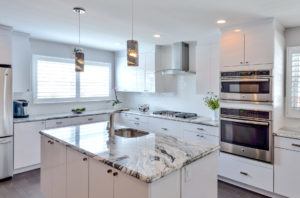
Each drawer or roll out in any cabinet will lose 3/4″ of space on each side so that the inside of every drawer in a framed line will be 1 1’2 ” narrower than in a frameless line.
For an average cabinet of 24″ in width this means that the storage capacity of any drawer or roll out is reduced about 8%. More in narrower cabinets but less as the cabinet gets wider. A cabinet to have all drawers or all roll outs the most that the storage space would be reduced on average would be 8 %. A cabinet with only a top drawer would only lose storage space for that top drawer and the cabinet below would hold the same amount. So, without roll outs a typical base cabinet with only a top drawer would lose at most 2% total storage. We are simplifying the calculations due to some other minimal factors we are not taking into account, but we are also being liberal in the overall storage savings.
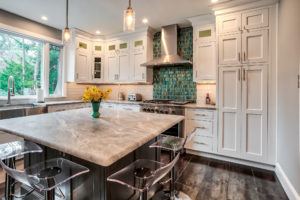
Most kitchen use more drawers and roll outs today so assuming that the bottoms of most tall and base cabinets use drawers or roll outs let’s say 6% of all the bottom cabinetry is lost. Since none of the storage in the tops of tall cabinets and wall cabinets loses space certainly the overall kitchen won’t lose more than 4% of its storage space using framed vs. frameless cabinetry.
A 4% loss of storage space is not such a large number.
By comparison choosing a range and a microwave hood above it in a kitchen can save 10% of the total storage in a small kitchen versus a design using a cooktop and a wall oven and microwave wall oven with a hood above the cooktop. Dividing cabinetry to create small spice pull out cabinets or tray divider cabinets can lose a similar 4% in a small kitchen. Even adding decorative 3″ wide legs on either side of a cooktop or sink would lose 5% of the base cabinet storage in a small kitchen, 10% if you did it in both places.
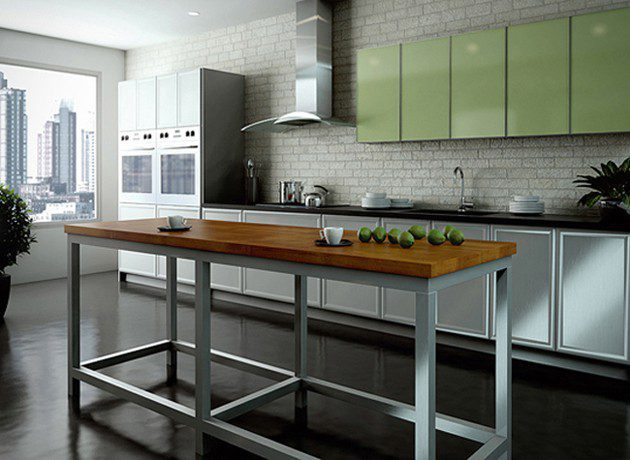
Frameless cabinetry is less durable than framed cabinetry because there is no solid wood front on the cabinet.
Cabinet fronts protect the cabinet box and frameless cabinet front edges are just 1/4″ thick edge banding at best. Having hinges and tracks screwed to the solid wood frame and screwing each frame to the face frame next to it is what makes well-made framed cabinetry capable of holding up over a lifetime. Face frames do get in the way which is why frameless cabinetry is also called “easy access cabinetry”.
Our takeaway from these space calculations and considering the durably issues is that we do not recommend using frameless cabinetry unless some of their other added benefits come into play.
Most notably, there is no question that if you want very contemporary slab doors in your kitchen these modern styles look better on frameless European style cabinets.
Door and drawer gaps on frameless cabinets are 1/4″ tighter due to how the frameless hinges operate and that gap makes a big difference in making a contemporary kitchen look sleek, modern, and stylish. Most modern foil, acrylic, and laminate slab doors styles will only be available in frameless cabinet lines. However, raised panel and recessed panel door styles like the popular shaker style look fine in framed lines.
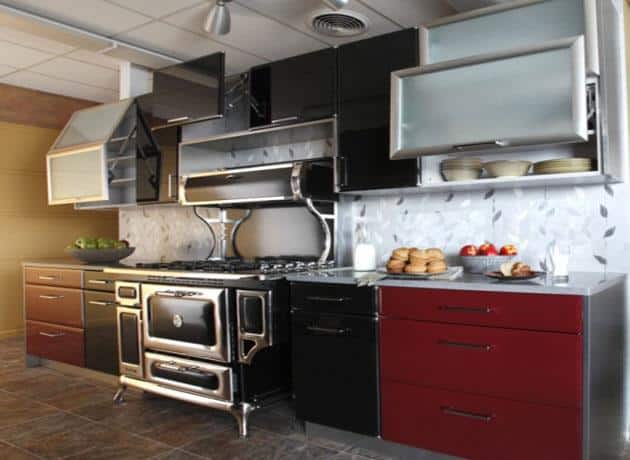
So, before you jump into a decision of one cabinet construction type over another, consider your options and do the math!
Below are some related posts:
https://www.mainlinekitchendesign.com/general/what-cabinet-line-is-the-best/
https://www.mainlinekitchendesign.com/philadelphia-kitchen-cabinets/cabinets-buying-guide/
Hoping that you will let our designers help you with your calculations and as always . . .
Bon Appetit!
Paul, Julie, Chris, Jeremy, Juliet, and Mark
Main Line Kitchen Design

2 Replies to “Storage Difference Between Framed and Frameless Cabinets. Let’s Do the Math.”
paul mcalary
Highland looks like an RTA cabinet made overseas and assembled in Denver. Looks OK but I have no idea on what kind of quality there would be in their finishes, how much they cost, or what kind of job the factory does assembling the cabinet. It also looks like they don’t use kitchen designers. Having your contractor design your kitchen would assure that it was poorly designed.
Jeanne tanner
Hi Paul!
Any reviews for highland cabinetry out of Denver?
My contractor uses this brand. I didn’t see it in the list?
The reviews are good. Dove tail drawers. Solid wood box enclosure. Not sure of the price yet? Getting a bid tomorrow.
Thanks
Laurie O’Neill
Thank you for the quick response!
Paul McAlary
Hi Laurie,
No both drawers will usually be the same depth.
Laurie O’Neill
Thank you for this great article comparing framed and frameless storage capacity. I now understand that you lose 1 1/2” of width in each drawer and roll out. Do you also lose any depth for drawers in a framed cabinet? I currently am looking to replace my frameless cabinets with framed ones…wondering if each of the drawers in my 4 bank of drawers, will be a little shallower to allow them to pass through the frame fronts above and below each drawer. Thanks so much for all the great advice you provide!